This four-movie, two-disc set from Turner Classics Movies and Warner
Home Video has everybody wondering if the transfers for this quartet of Hammer
Horror classics are any different from what was previously released. The answer
is no, and even the menus and features are identical. So, you’re not going
to get the long-awaited BFI restoration of HORROR OF DRACULA that’s been
talked about on the internet over the past few years (at least not with this
set), but we’ll revisit these titles anyway, and for anyone who hasn’t
purchased any of the titles in the past, this collection of course comes highly
recommended. Disc 1 features HORROR OF DRACULA (aka DRACULA) on Side A and DRACULA
HAS RISEN FROM THE GRAVE on the flip side, and Disc 2 contains CURSE OF FRANKENSTEIN
on Side A, and you’ll flip over to Side B for FRANKENSTEIN MUST BE DESTROYED.
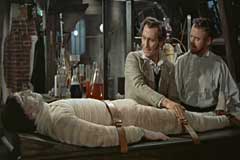
With THE CURSE OF FRANKENSTEIN and HORROR OF DRACULA, England’s
Hammer Films revitalized the horror genre in the 1950s with some much needed
gothic flavor. The independent company was able to churn out lavish looking
films for next to nothing in cost, and they made stars out of Peter Cushing
and Christopher Lee, two of the greatest actors ever to grace the silver screen.
The director of both films, Terence Fisher, would also become a sort of specialist
in the area of period monster melodramas.
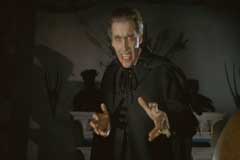 Much
has already been written on THE CURSE OF FRANKENSTEIN and HORROR OF DRACULA,
and if you're reading this, you probably know a good deal about them. Not only
are they two of the finest films of their kind ever produced, but they were
also a phenomenal success worldwide and influenced studios in nearly every other
country in terms of style and execution. These two efforts had extra doses of
blood and sexuality not seen in most prior horror outings, and they were wrapped
up in pretty, coloroful packages with superior acting and cinematography as
well.
Much
has already been written on THE CURSE OF FRANKENSTEIN and HORROR OF DRACULA,
and if you're reading this, you probably know a good deal about them. Not only
are they two of the finest films of their kind ever produced, but they were
also a phenomenal success worldwide and influenced studios in nearly every other
country in terms of style and execution. These two efforts had extra doses of
blood and sexuality not seen in most prior horror outings, and they were wrapped
up in pretty, coloroful packages with superior acting and cinematography as
well.

In terms of its Technicolor splendor, this 2002 DVD transfer for HORROR
OF DRACULA at least succeeds in that department. HORROR has never looked that
good in past video versions, and Warner's initial VHS release had a considerable
amount of damage in the second reel of the print source. On the DVD, blemishes
are nonexistent and its Technicolor origins are presented in full force, with
colors looking vivid (especially the blood reds that Hammer is known for). There
is much detail in the picture, such at the Fall leaves during nighttime shots,
and all the backdrop trinkets in Dracula's castle, giving much-needed compliments
to Jack Asher beautiful cinematography and Bernard Robinson's elaborate set
design. The 1.78:1 aspect ratio is apparently too tight on the top and bottom,
and the still unreleased BFI restored version is supposed to be remedying this.
Still, when compared to Warner’s prior full screen VHS and laserdisc released
of the film, the DVD transfer adds a lot more picture information to both sides
of the screen. Take for example a shot where Cushing and Michael Gough are conversing
with George Benson; in the full frame version, Cushing, as well as half of Gough's
head, are not seen as they do in the letterboxed one. Another good example is
a shot where Dracula (off to the far left of the screen) is seen trying to escape
in a trap door; he's at least fully visible here.
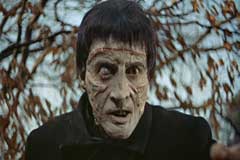 THE
CURSE OF FRANKENSTEIN looks quite impressive. Letterboxed at 1.78:1 with anamorphic
enhancement, Warner’s 2002 DVD transfer is a vast improvement over past
video versions, as this title never looked right on VHS or laserdisc in the
past (the full frame video version looked as though it was culled from a worn
16mm source, while the letterboxed laserdisc had dull colors). The DVD presents
a clean picture, remarkably crisp and highly detailed, nicely bringing out the
deep saturated colors of Frankenstein's laboratory, and the elegant period clothing
worn by the actors. So great is the detail that close-up shots of Lee's fleshy
stitched-up creature are made even more intense. The framing comes off with
no noticeable problems, adding much more to the sides than the old full screen
counterpart.
THE
CURSE OF FRANKENSTEIN looks quite impressive. Letterboxed at 1.78:1 with anamorphic
enhancement, Warner’s 2002 DVD transfer is a vast improvement over past
video versions, as this title never looked right on VHS or laserdisc in the
past (the full frame video version looked as though it was culled from a worn
16mm source, while the letterboxed laserdisc had dull colors). The DVD presents
a clean picture, remarkably crisp and highly detailed, nicely bringing out the
deep saturated colors of Frankenstein's laboratory, and the elegant period clothing
worn by the actors. So great is the detail that close-up shots of Lee's fleshy
stitched-up creature are made even more intense. The framing comes off with
no noticeable problems, adding much more to the sides than the old full screen
counterpart.

The mono sound on both HORROR and CURSE is excellent. There isn't any
noticeable distortion or background hiss (aside from occasional pops on CURSE),
nicely amplifying the late James Bernard's now legendary scores while dialog
and sound effects remain distinct. CURSE has an alternate French language track,
and both titles carry English, French, Spanish and Portuguese subtitles, and
English closed captions. Don't expect to see any of the infamous missing alternative
gore footage (reportedly shot for the Japanese markets), unless you count the
bloody staking missing from some video versions (gladly, reinstated here) in
HORROR. Featurettes for both these titles were proposed early on (I myself submitted
some materials to be used) but later canceled, which is indeed a shame. The
only extras are histories of Hammer's Frankenstein series (for CURSE) and Dracula
series (for HORROR) which are pretty skimpy, as well as skim cast/crew rundowns.
Both titles have their appropriate trailer, and while they don't look nearly
as good as the features, they are far better then when witnessed on various
past PD trailer compilations.
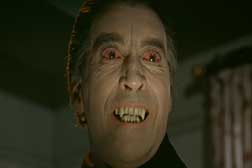 Hammer
Films' output of Dracula movies had previously been the sole property of their
most celebrated director, Terence Fisher (who not only helmed HORROR OF DRACULA,
but also BRIDES OF DRACULA in 1960 and DRACULA PRINCE OF DARKNESS in 1965).
By the late 1960s, Hammer continued the series in rapid mode, but started to
bring other directors to the fold, in this case Freddie Francis, who had already
helmed a gothic (THE EVIL OF FRANKENSTEIN) for the company and was also a renowned
cinematographer. DRACULA HAS RISEN FROM THE GRAVE features a script by Hammer
regular Anthony Hinds (aka John Elder), a roaring score by Hammer's in-house
composer James Bernard, the usual high level of production values and acting
talent, and of course, the eminent Christopher Lee donning the red-lined cloak
and pointy fangs, and not for the final time (he would essay the role in four
more outings for Hammer).
Hammer
Films' output of Dracula movies had previously been the sole property of their
most celebrated director, Terence Fisher (who not only helmed HORROR OF DRACULA,
but also BRIDES OF DRACULA in 1960 and DRACULA PRINCE OF DARKNESS in 1965).
By the late 1960s, Hammer continued the series in rapid mode, but started to
bring other directors to the fold, in this case Freddie Francis, who had already
helmed a gothic (THE EVIL OF FRANKENSTEIN) for the company and was also a renowned
cinematographer. DRACULA HAS RISEN FROM THE GRAVE features a script by Hammer
regular Anthony Hinds (aka John Elder), a roaring score by Hammer's in-house
composer James Bernard, the usual high level of production values and acting
talent, and of course, the eminent Christopher Lee donning the red-lined cloak
and pointy fangs, and not for the final time (he would essay the role in four
more outings for Hammer).
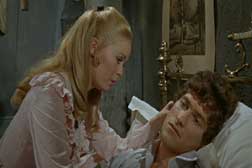
When the damage of vampirism still plagues a small village, a brave
Monsignor (Rupert Davies) and an easily manipulated priest (Ewan Hooper) travel
to Castle Dracula to exorcise it. Planting a huge gold cross on Dracula's door
only makes matter worse when he (Christopher Lee) is revived from his icy coma,
and enacts revenge on the Monsignor. The priest is made Dracula's lackey, and
after putting the bite on a busty tease of a barmaid (Barbara Ewing), he sets
his sights on the Monsignor's innocent niece Maria (Veronica Carlson), who is
in love with atheist baker Paul (Barry Andrews). Paul must look for his true
inner faith in order to protect and save his beloved Maria from the most evil
man alive (or undead if you will).
 Freddie
Francis injects much excitement, fascinating camera work, and some highly memorable
scenes in DRACULA HAS RISEN FROM THE GRAVE, and despite his limited screen time
and limited dialog, Lee is an imposing figure who steals every scene he's in.
Hinds' script has its weak points, even toying around with vampire lore in a
would-be death scene, but this is prime Hammer gothic horror, and became one
of their biggest money makers. Rupert Davies' Monsignor is a more than acceptable
substitute for Peter Cushing's Van Helsing and as the heroine, Veronica Carlson
proves to be one of the most talented and beautiful actresses that the company
ever hired. She would prove this even more so in the following year's FRANKENSTEIN
MUST BE DESTROYED and would later be cast opposite Ralph Bates in THE HORROR
OF FRANKENSTEIN (1970). Barry Andrews would go on to star in another fine British
horror film, this time for Tigon: THE BLOOD ON SATAN'S CLAW (aka SATAN'S SKIN)
(1971).
Freddie
Francis injects much excitement, fascinating camera work, and some highly memorable
scenes in DRACULA HAS RISEN FROM THE GRAVE, and despite his limited screen time
and limited dialog, Lee is an imposing figure who steals every scene he's in.
Hinds' script has its weak points, even toying around with vampire lore in a
would-be death scene, but this is prime Hammer gothic horror, and became one
of their biggest money makers. Rupert Davies' Monsignor is a more than acceptable
substitute for Peter Cushing's Van Helsing and as the heroine, Veronica Carlson
proves to be one of the most talented and beautiful actresses that the company
ever hired. She would prove this even more so in the following year's FRANKENSTEIN
MUST BE DESTROYED and would later be cast opposite Ralph Bates in THE HORROR
OF FRANKENSTEIN (1970). Barry Andrews would go on to star in another fine British
horror film, this time for Tigon: THE BLOOD ON SATAN'S CLAW (aka SATAN'S SKIN)
(1971).
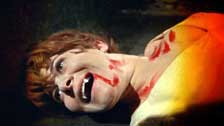
Although some collector's might still be hanging on to the widescreen
laserdisc, DRACULA HAS RISEN FROM THE GRAVE fairs far better with this 2004
DVD transfer, letterboxed in a fitting 1.78:1 aspect ratio with anamorphic enhancement.
The print source is in excellent shape, with only hints of grain on occasion.
Blacks are pretty intense, and fleshtones are very good for the most part. Colors
are strong, and Francis' use of special colored camera lenses really stand out
in this presentation. The mono sound is also surprisingly strong for a film
of its age, and there's an additional French track, as well at optional English,
French and Spanish subtitles. The only extra is the original theatrical trailer,
but it least it looks much better than what we've seen of it on numerous horror
trailer compilations.
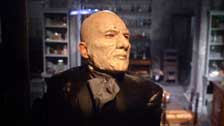 Hammer’s
Frankenstein series had always centered on the doctor rather than his creation.
Peter Cushing's personification of Baron Frankenstein was so well-identified
by the public by the late 1960s, that 1967's FRANKENSTEIN CREATED WOMAN no longer
required the lumbering monster. For 1969's FRANKENSTEIN MUST BE DESTROYED, Cushing's
characterization was more intense than ever, helping to deliver the most unique
entry in the series, and arguably the best. If there had been acting honors
for horror films that year, Mr. Cushing certainly would have garnered the top
award.
Hammer’s
Frankenstein series had always centered on the doctor rather than his creation.
Peter Cushing's personification of Baron Frankenstein was so well-identified
by the public by the late 1960s, that 1967's FRANKENSTEIN CREATED WOMAN no longer
required the lumbering monster. For 1969's FRANKENSTEIN MUST BE DESTROYED, Cushing's
characterization was more intense than ever, helping to deliver the most unique
entry in the series, and arguably the best. If there had been acting honors
for horror films that year, Mr. Cushing certainly would have garnered the top
award.
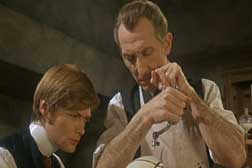
FRANKENSTEIN MUST BE DESTROYED was Hammer's fifth Frankenstein film,
and the fourth one to be directed by Terence Fisher, who often regarded this
as his favorite work. Baron Frankenstein (Cushing) is introduced hiding out
and conducting his bizarre experiments in an abandoned villa. He lops of the
head off of a colleague and later confronts a prowler who runs to the police
covered in blood after a confrontaion in his lab. Knowing he's got to get away,
he hides the evidence and makes his way to the boarding house of young Anna
Spengler (Veronica Carlson), using the name "Mr. Fenner." When Frankenstein
learns that Anna's boyfriend Karl (Simon Ward) is dealing drugs pinched from
the asylum that he works at, he blackmails the couple into aiding him with his
experiments while keeping his identity a secret from the public.
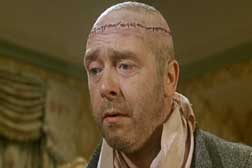 As
the bumbling police further their search for the culprit of the first murder,
Karl unintentionally kills a night watchman while he and Frankenstein steal
medical supplies. Frankenstein and Karl kidnap Dr. Brandt (George Pravda), a
basket case asylum inmate who happens to be the Baron's ex-partner and solely
possesses scientific information vital to his research. In order to gain the
knowledge, the brain from his dying body is transformed into another doctor
(allowing for an overdose of trademark Hammer blood), and the resulting "creature"
is brilliantly played by Freddie Jones. Brandt awakens to see the shaven, surgery-scarred
face of another man and manages to escape, wounded and in utter horror. He makes
his way to his home, but his wife Ella (Maxine Audley) ultimately rejects him
and he swears fierce revenge on Frankenstein, even if it means his own life.
As
the bumbling police further their search for the culprit of the first murder,
Karl unintentionally kills a night watchman while he and Frankenstein steal
medical supplies. Frankenstein and Karl kidnap Dr. Brandt (George Pravda), a
basket case asylum inmate who happens to be the Baron's ex-partner and solely
possesses scientific information vital to his research. In order to gain the
knowledge, the brain from his dying body is transformed into another doctor
(allowing for an overdose of trademark Hammer blood), and the resulting "creature"
is brilliantly played by Freddie Jones. Brandt awakens to see the shaven, surgery-scarred
face of another man and manages to escape, wounded and in utter horror. He makes
his way to his home, but his wife Ella (Maxine Audley) ultimately rejects him
and he swears fierce revenge on Frankenstein, even if it means his own life.
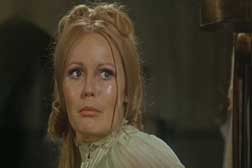
FRANKENSTEIN MUST BE DESTOYED is not only one of the finest of Hammer
movies, it's also one of the finest that the genre has to offer. Fisher's direction
is masterful, at times evoking tension worthy of Alfred Hitchcock. The screenplay
by Bert Batt and Anthony Nelson Keys presents one of the most original Frankenstein
premises, full of dark melodrama, anti-heroes forced to do the villain's bidding,
and two coinciding doomed romances. Veronica Carlson's tragic heroine makes
her one of Hammer's most remarkable and talented leading ladies. Simon Ward,
Maxine Audley, Geoffrey Bayldon and Thorley Walters all get high acting nods,
but Freddie Jones –
as the pathetic yet love torn and vengeful creature
– is most impressive. Most impressive that is next to Cushing,
who plays the Baron more wicked and determined than ever. Frankenstein is a
murderous, conniving, chauvinistic, raping mad genius who can turn on the charm
when the moment calls for it, and this film gives Cushing his all-time best
genre performance. From his opening scenes as a rubber-masked assassin to the
fiery "cat and mouse" climax, FRANKENSTEIN MUST BE DESTROYED is a
gothic masterpiece and a must-see/must-own title for any serious horror film
fan.
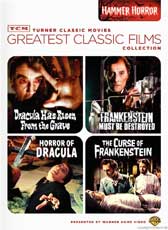 GREATEST
CLASSIC FILMS COLLECTION: HAMMER HORROR – HORROR OF DRACULA (1958),
DRACULA HAS RISEN FROM THE GRAVE (1968), THE CURSE OF FRANKENSTEIN (1957), FRANKENSTEIN
MUST BE DESTROYED (1969)
GREATEST
CLASSIC FILMS COLLECTION: HAMMER HORROR – HORROR OF DRACULA (1958),
DRACULA HAS RISEN FROM THE GRAVE (1968), THE CURSE OF FRANKENSTEIN (1957), FRANKENSTEIN
MUST BE DESTROYED (1969)
 Much
has already been written on THE CURSE OF FRANKENSTEIN and HORROR OF DRACULA,
and if you're reading this, you probably know a good deal about them. Not only
are they two of the finest films of their kind ever produced, but they were
also a phenomenal success worldwide and influenced studios in nearly every other
country in terms of style and execution. These two efforts had extra doses of
blood and sexuality not seen in most prior horror outings, and they were wrapped
up in pretty, coloroful packages with superior acting and cinematography as
well.
Much
has already been written on THE CURSE OF FRANKENSTEIN and HORROR OF DRACULA,
and if you're reading this, you probably know a good deal about them. Not only
are they two of the finest films of their kind ever produced, but they were
also a phenomenal success worldwide and influenced studios in nearly every other
country in terms of style and execution. These two efforts had extra doses of
blood and sexuality not seen in most prior horror outings, and they were wrapped
up in pretty, coloroful packages with superior acting and cinematography as
well. 
 THE
CURSE OF FRANKENSTEIN looks quite impressive. Letterboxed at 1.78:1 with anamorphic
enhancement, Warner’s 2002 DVD transfer is a vast improvement over past
video versions, as this title never looked right on VHS or laserdisc in the
past (the full frame video version looked as though it was culled from a worn
16mm source, while the letterboxed laserdisc had dull colors). The DVD presents
a clean picture, remarkably crisp and highly detailed, nicely bringing out the
deep saturated colors of Frankenstein's laboratory, and the elegant period clothing
worn by the actors. So great is the detail that close-up shots of Lee's fleshy
stitched-up creature are made even more intense. The framing comes off with
no noticeable problems, adding much more to the sides than the old full screen
counterpart.
THE
CURSE OF FRANKENSTEIN looks quite impressive. Letterboxed at 1.78:1 with anamorphic
enhancement, Warner’s 2002 DVD transfer is a vast improvement over past
video versions, as this title never looked right on VHS or laserdisc in the
past (the full frame video version looked as though it was culled from a worn
16mm source, while the letterboxed laserdisc had dull colors). The DVD presents
a clean picture, remarkably crisp and highly detailed, nicely bringing out the
deep saturated colors of Frankenstein's laboratory, and the elegant period clothing
worn by the actors. So great is the detail that close-up shots of Lee's fleshy
stitched-up creature are made even more intense. The framing comes off with
no noticeable problems, adding much more to the sides than the old full screen
counterpart.
 Hammer
Films' output of Dracula movies had previously been the sole property of their
most celebrated director, Terence Fisher (who not only helmed HORROR OF DRACULA,
but also BRIDES OF DRACULA in 1960 and DRACULA PRINCE OF DARKNESS in 1965).
By the late 1960s, Hammer continued the series in rapid mode, but started to
bring other directors to the fold, in this case Freddie Francis, who had already
helmed a gothic (THE EVIL OF FRANKENSTEIN) for the company and was also a renowned
cinematographer. DRACULA HAS RISEN FROM THE GRAVE features a script by Hammer
regular Anthony Hinds (aka John Elder), a roaring score by Hammer's in-house
composer James Bernard, the usual high level of production values and acting
talent, and of course, the eminent Christopher Lee donning the red-lined cloak
and pointy fangs, and not for the final time (he would essay the role in four
more outings for Hammer).
Hammer
Films' output of Dracula movies had previously been the sole property of their
most celebrated director, Terence Fisher (who not only helmed HORROR OF DRACULA,
but also BRIDES OF DRACULA in 1960 and DRACULA PRINCE OF DARKNESS in 1965).
By the late 1960s, Hammer continued the series in rapid mode, but started to
bring other directors to the fold, in this case Freddie Francis, who had already
helmed a gothic (THE EVIL OF FRANKENSTEIN) for the company and was also a renowned
cinematographer. DRACULA HAS RISEN FROM THE GRAVE features a script by Hammer
regular Anthony Hinds (aka John Elder), a roaring score by Hammer's in-house
composer James Bernard, the usual high level of production values and acting
talent, and of course, the eminent Christopher Lee donning the red-lined cloak
and pointy fangs, and not for the final time (he would essay the role in four
more outings for Hammer). 
 Freddie
Francis injects much excitement, fascinating camera work, and some highly memorable
scenes in DRACULA HAS RISEN FROM THE GRAVE, and despite his limited screen time
and limited dialog, Lee is an imposing figure who steals every scene he's in.
Hinds' script has its weak points, even toying around with vampire lore in a
would-be death scene, but this is prime Hammer gothic horror, and became one
of their biggest money makers. Rupert Davies' Monsignor is a more than acceptable
substitute for Peter Cushing's Van Helsing and as the heroine, Veronica Carlson
proves to be one of the most talented and beautiful actresses that the company
ever hired. She would prove this even more so in the following year's FRANKENSTEIN
MUST BE DESTROYED and would later be cast opposite Ralph Bates in THE HORROR
OF FRANKENSTEIN (1970). Barry Andrews would go on to star in another fine British
horror film, this time for Tigon: THE BLOOD ON SATAN'S CLAW (aka SATAN'S SKIN)
(1971).
Freddie
Francis injects much excitement, fascinating camera work, and some highly memorable
scenes in DRACULA HAS RISEN FROM THE GRAVE, and despite his limited screen time
and limited dialog, Lee is an imposing figure who steals every scene he's in.
Hinds' script has its weak points, even toying around with vampire lore in a
would-be death scene, but this is prime Hammer gothic horror, and became one
of their biggest money makers. Rupert Davies' Monsignor is a more than acceptable
substitute for Peter Cushing's Van Helsing and as the heroine, Veronica Carlson
proves to be one of the most talented and beautiful actresses that the company
ever hired. She would prove this even more so in the following year's FRANKENSTEIN
MUST BE DESTROYED and would later be cast opposite Ralph Bates in THE HORROR
OF FRANKENSTEIN (1970). Barry Andrews would go on to star in another fine British
horror film, this time for Tigon: THE BLOOD ON SATAN'S CLAW (aka SATAN'S SKIN)
(1971). 
 Hammer’s
Frankenstein series had always centered on the doctor rather than his creation.
Peter Cushing's personification of Baron Frankenstein was so well-identified
by the public by the late 1960s, that 1967's FRANKENSTEIN CREATED WOMAN no longer
required the lumbering monster. For 1969's FRANKENSTEIN MUST BE DESTROYED, Cushing's
characterization was more intense than ever, helping to deliver the most unique
entry in the series, and arguably the best. If there had been acting honors
for horror films that year, Mr. Cushing certainly would have garnered the top
award.
Hammer’s
Frankenstein series had always centered on the doctor rather than his creation.
Peter Cushing's personification of Baron Frankenstein was so well-identified
by the public by the late 1960s, that 1967's FRANKENSTEIN CREATED WOMAN no longer
required the lumbering monster. For 1969's FRANKENSTEIN MUST BE DESTROYED, Cushing's
characterization was more intense than ever, helping to deliver the most unique
entry in the series, and arguably the best. If there had been acting honors
for horror films that year, Mr. Cushing certainly would have garnered the top
award.
 As
the bumbling police further their search for the culprit of the first murder,
Karl unintentionally kills a night watchman while he and Frankenstein steal
medical supplies. Frankenstein and Karl kidnap Dr. Brandt (George Pravda), a
basket case asylum inmate who happens to be the Baron's ex-partner and solely
possesses scientific information vital to his research. In order to gain the
knowledge, the brain from his dying body is transformed into another doctor
(allowing for an overdose of trademark Hammer blood), and the resulting "creature"
is brilliantly played by Freddie Jones. Brandt awakens to see the shaven, surgery-scarred
face of another man and manages to escape, wounded and in utter horror. He makes
his way to his home, but his wife Ella (Maxine Audley) ultimately rejects him
and he swears fierce revenge on Frankenstein, even if it means his own life.
As
the bumbling police further their search for the culprit of the first murder,
Karl unintentionally kills a night watchman while he and Frankenstein steal
medical supplies. Frankenstein and Karl kidnap Dr. Brandt (George Pravda), a
basket case asylum inmate who happens to be the Baron's ex-partner and solely
possesses scientific information vital to his research. In order to gain the
knowledge, the brain from his dying body is transformed into another doctor
(allowing for an overdose of trademark Hammer blood), and the resulting "creature"
is brilliantly played by Freddie Jones. Brandt awakens to see the shaven, surgery-scarred
face of another man and manages to escape, wounded and in utter horror. He makes
his way to his home, but his wife Ella (Maxine Audley) ultimately rejects him
and he swears fierce revenge on Frankenstein, even if it means his own life.

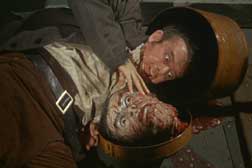 Warner
Home Video has done a terrific job preserving another Hammer title on DVD with
this 2004 transfer. FRANKENSTEIN MUST BE DESTROYED is presented in a 1.78:1
aspect ratio with anamorphic enhancement. The image is quite sharp and offers
an impressive level of detail. Colors are very strong and vibrant, and far less
muted than they were in previous VHS and laserdisc versions. The mono audio
maintains James Bernard's memorable score full-bodied despite occasional hiss
during dialog. There's also a secondary French dialog track, as well as optional
English, French and Spanish subtitles. The theatrical trailer is included, and
note that this is the complete version of the film, including the notorious
rape scene that was originally removed from the U.S. theatrical version (the
film is now rated "PG-13" for "violence and horror images").
(George
R. Reis)
Warner
Home Video has done a terrific job preserving another Hammer title on DVD with
this 2004 transfer. FRANKENSTEIN MUST BE DESTROYED is presented in a 1.78:1
aspect ratio with anamorphic enhancement. The image is quite sharp and offers
an impressive level of detail. Colors are very strong and vibrant, and far less
muted than they were in previous VHS and laserdisc versions. The mono audio
maintains James Bernard's memorable score full-bodied despite occasional hiss
during dialog. There's also a secondary French dialog track, as well as optional
English, French and Spanish subtitles. The theatrical trailer is included, and
note that this is the complete version of the film, including the notorious
rape scene that was originally removed from the U.S. theatrical version (the
film is now rated "PG-13" for "violence and horror images").
(George
R. Reis)